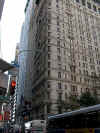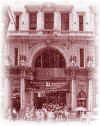In the middle of the nineteenth
century, New York City's residential and commercial districts
were pressing ever northward along Broadway. This acutely
observed mid-century watercolor captures some of the unusual
juxtapositions engendered by this movement. The massive new
Empire Building opened in the early 1850s to house both offices
and stores (it replaced the earlier Grace Church, which by 1843
had voted to follow its parishioners who were building fine
homes in the Union Square neighborhood).1
The Empire Building stood in sharp contrast to the tranquil
cemetery of Trinity Church. Former New York mayor Philip Hone,
an avid diarist, recorded that Grace Church had sold in 1845 for
$65,000, "to be converted into stores below and the upper part
into a splendid museum of Chinese curiosities." The lack of any
known record substantiating these plans for the deconsecrated
Grace Church suggests that they never progressed.
Located at 71 and 73 Broadway, at
the corner of Rector Street (named for the succession of
eighteenth-century rectors of Trinity Church who lived on the
site before Grace Church was built there in 1807), the Empire
Building housed several dry-goods merchants at street level and
various business offices in its upper stories.2
In 1896 -1897 a newer, taller Empire Building replaced the
commercial structure depicted in this view, which then received
the appellation "Old Empire Building."
From the early eighteenth century
forward, Trinity Church cemetery, on the corner opposite the
Empire Building, had served as the final resting place of many
notable Americans, including Francis Lewis, signer of the
Declaration of Independence; inventor Robert Fulton;
financier-statesman Alexander Hamilton; and William Bradford,
founder of New York's first newspaper, The New-York Gazette.3
While the painting's composition
allots equal space to the Empire Building and the graveyard, the
sheer size of the new structure gives it prominence, suggesting
the significance attached to a modern edifice of commerce in a
city that was rapidly evolving into the center of American
business enterprise. The pedestrians and vehicles along Broadway
show the variety of traffic. Many elegantly attired men, women,
and children saunter along the sidewalks; a more modestly
dressed family (possibly visitors from the country) can be
discerned at the extreme right; and two boys are seen going
about their business, one (near the corner of the Trinity
graveyard fence) bearing a package he may be delivering, and the
other (at bottom center) apparently approaching people with
something to sell. The artist may have intended to compare the
old cemetery's appearance of repose with the dynamic street
scene and the commercial energy typifying the modern New York
Cityscape.
John William Hill, son of the
engraver John Hill, was born in London and immigrated with his
family to the United States at the age of seven, initially
residing in Philadelphia and then moving to New York City in
1822, where he served a seven-year apprenticeship to his father.
In 1828 Hill began to exhibit work at the National Academy of
Design. Five years later he was elected an associate member, and
he continued to exhibit fairly regularly there until 1873. He
was employed as a topographical artist for the New York State
Geological Survey from 1836 to 1841, after which he worked for
Smith Brothers, a publishing firm, where he was employed to
sketch North America's developing cities. From the mid-1850s on,
Hill was greatly influenced by the tenets of the Pre-Raphaelite
movement and devoted himself largely to painting from nature.4
This work, with its strong attention to tonal values and contrasts
of light and dark and its acutely observed architectural detail,
demonstrates the influence of his earlier experience in the
employ of printmakers. To a slightly lesser extent, the same
qualities inform Hill's landscape paintings.
Notes:
1 There
is no known record of the Old Empire Building's designer or
builder. It has little stylistic distinction, being typical of
massive commercial buildings of the period.
2 Among
the office tenants in the Empire Building was financier Russell
Sage (1816 -1906), who was elected to Congress in 1852 and who,
with Jay Gould, later made a fortune amounting to $70 million in
railroads and on Wall Street. When he died, his wife, Olivia
Sage, proceeded to give most of it to various charities,
including a foundation bearing his name.
3 Following
the 1830 ordinance prohibiting burials below Canal Street,
Trinity Church opened a new cemetery at 155th Street and
Riverside Drive. Among the wealthy and socially prominent church
members interred there are John Jacob Astor, Clement Clark
Moore, and Alfred Tennyson Dickens, son of Charles Dickens.
4 Richard
J. Koke, American Landscape and Genre Paintings in the
New-York Historical Society (New York: New-York Historical
Society, 1982), vol. 2, pp. 134 -135.


